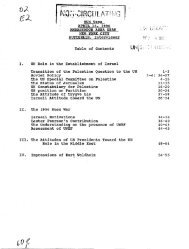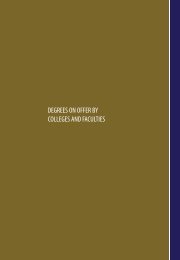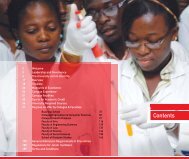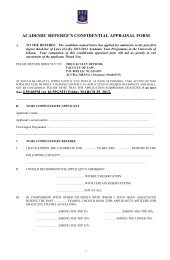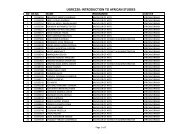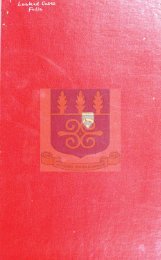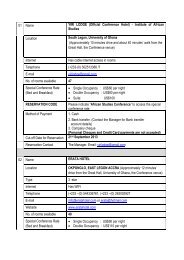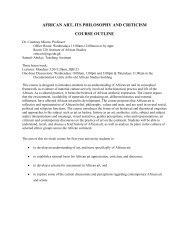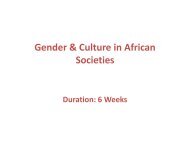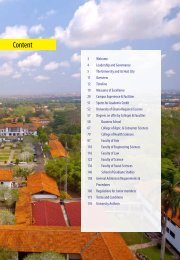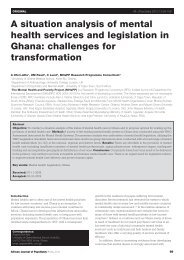African Art, Its Philosophy and Criticism Course Outline - Institute of ...
African Art, Its Philosophy and Criticism Course Outline - Institute of ...
African Art, Its Philosophy and Criticism Course Outline - Institute of ...
You also want an ePaper? Increase the reach of your titles
YUMPU automatically turns print PDFs into web optimized ePapers that Google loves.
UGRC 220 ELECTIVE: AFRICAN ART, ITS PHILOSOPHY<br />
AND CRITICISM<br />
Lecturers: Dr. Kwame Labi<br />
Graduate Teaching Assistants: Samuel Abokyi & Esther Naa Darku<br />
Three hours/week:<br />
Lectures: Monday 3:30-5:20pm (NNB1)<br />
One-hour Tutorials: TBD<br />
This course is designed to introduce students to an underst<strong>and</strong>ing <strong>of</strong> <strong>African</strong> art <strong>and</strong> its conceptual<br />
framework as evidence <strong>of</strong> material culture actively involved in the historical process <strong>and</strong> life <strong>of</strong> the<br />
<strong>African</strong>. As a cultural practice, it forms the bedrock <strong>of</strong> <strong>African</strong> aesthetic expression. The course argues<br />
that the environment, availability <strong>of</strong> materials for producing art, different histories <strong>and</strong> external<br />
influences, have affected <strong>African</strong> art <strong>and</strong> its development. The course proposes that <strong>African</strong> art is<br />
reflective <strong>and</strong> representative <strong>of</strong> <strong>African</strong> belief, philosophy, values <strong>and</strong> taste, <strong>and</strong> is used in social, political<br />
<strong>and</strong> religious functions. The course introduces the forms <strong>of</strong> art historical <strong>and</strong> theoretical enquiries <strong>and</strong><br />
approaches to the subject such as art as history, aesthetics, style, subject <strong>and</strong> subject matter,<br />
interpretations <strong>and</strong> meanings, visual narratives, gender perceptions, roles <strong>and</strong> representations, art criticism<br />
<strong>and</strong> contemporary discourses on the practice <strong>of</strong> art on the continent. Students will be able to underst<strong>and</strong>,<br />
recall, <strong>and</strong> discuss a brief history <strong>of</strong> <strong>African</strong> art, as well as analyze its place in the cultures <strong>of</strong> selected<br />
ethnic groups across the <strong>African</strong> continent.<br />
The aim <strong>of</strong> this 6-week elective <strong>African</strong> Studies course is:<br />
<br />
<br />
<br />
to develop a better underst<strong>and</strong>ing <strong>of</strong> the place <strong>of</strong> art in the life <strong>and</strong> history <strong>of</strong> <strong>African</strong>s<br />
to build an awareness <strong>of</strong> the theories <strong>and</strong> methodologies <strong>of</strong> the discipline <strong>of</strong> <strong>African</strong> art history<br />
to establish a rational basis for <strong>African</strong> art appreciation, criticism, <strong>and</strong> discourse<br />
The course consists <strong>of</strong> a class lecture (Mondays 3.30 pm-5.20 pm) <strong>and</strong> a tutorial session (times TBD) to<br />
explore ideas <strong>and</strong> issues presented in class lectures.<br />
Weeks 1-3 provide an introduction to <strong>African</strong> art, its philosophies, <strong>and</strong> the discipline <strong>of</strong> <strong>African</strong> art<br />
history. Weeks 4-6 introduce the historic <strong>and</strong> contemporary arts <strong>of</strong> major geographical <strong>and</strong> cultural<br />
regions.<br />
Assigned readings are available: 1) online in the UGRC 220 course list on the <strong>Institute</strong> <strong>of</strong> <strong>African</strong> Studies<br />
website; <strong>and</strong> 2) as photocopies in a course Reading Packet at the IAS Library.<br />
A review <strong>of</strong> this elective course for your exam will be provided by the graduate teaching assistant (date<br />
<strong>and</strong> time TBD). The exam (worth 70% <strong>of</strong> the UGRC 220 course grade) will consist <strong>of</strong>: slide IDs (name,<br />
ethnic group/artist, & function); map IDs; <strong>and</strong> essay questions. (One compulsory essay question will be<br />
based on material covered during the tutorial sessions.)
Introducing <strong>African</strong> <strong>Art</strong><br />
Topics<br />
Exploration <strong>of</strong> the many forms <strong>and</strong> functions <strong>of</strong> <strong>African</strong><br />
art; the artists who create them; <strong>and</strong> the role <strong>of</strong> gender in<br />
<strong>African</strong> art <strong>and</strong> artistry.<br />
Readings<br />
Perani, Judith <strong>and</strong> Smith, Fred. “Introduction.” The<br />
Visual <strong>Art</strong>s <strong>of</strong> Africa: Gender, Power, <strong>and</strong> Life<br />
Cycle Rituals. pp. 1-19. NJ: Prentice Hall, 1998.<br />
The <strong>Philosophy</strong> <strong>of</strong> <strong>African</strong> <strong>Art</strong><br />
Examination <strong>of</strong> the impact <strong>of</strong> <strong>African</strong> philosophies on art<br />
forms <strong>and</strong> the creative process, <strong>and</strong> the value <strong>of</strong><br />
underst<strong>and</strong>ing <strong>African</strong> art in terms <strong>of</strong> cultural practices,<br />
beliefs, <strong>and</strong> aesthetic systems.<br />
Abiodun, Rowl<strong>and</strong>. “<strong>African</strong> Aesthetics.” Journal <strong>of</strong><br />
Aesthetic Education 35 (2001) 4: 15-23.<br />
The Study <strong>of</strong> <strong>African</strong> <strong>Art</strong><br />
Review <strong>of</strong> the history <strong>of</strong> <strong>African</strong> art history as an<br />
academic discipline, with an examination <strong>of</strong> critical<br />
approaches <strong>and</strong> methodologies used in the study <strong>of</strong><br />
<strong>African</strong> art.<br />
Drewal, Henry John. “<strong>African</strong> <strong>Art</strong> Studies Today,”<br />
from <strong>African</strong> <strong>Art</strong> Studies: The State <strong>of</strong> the<br />
Discipline, pp. 29-62. Washington, DC: National<br />
Museum <strong>of</strong> <strong>African</strong> <strong>Art</strong>, 1990.<br />
North <strong>and</strong> East Africa<br />
Introduction to the arts <strong>of</strong> North <strong>and</strong> East Africa, with a<br />
focus on selected cultural groups.<br />
Readings from A History <strong>of</strong> <strong>Art</strong> in Africa, 2008:<br />
Early Nile Cultures & Kemet/Egypt, pp. 44-56<br />
The Swahili Coast, pp. 430-438<br />
Pastoral cultures <strong>of</strong> East Africa, pp. 457-461<br />
West Africa<br />
Introduction to the arts <strong>of</strong> West Africa, with a focus on<br />
selected cultural groups.<br />
Readings from A History <strong>of</strong> <strong>Art</strong> in Africa, 2008:<br />
The M<strong>and</strong>e, pp. 104-105, 112-123<br />
The Akan, pp. 196-204, 222-224<br />
The Benin Kingdom, pp. 273-283<br />
Central <strong>and</strong> Southern Africa<br />
Introduction to the arts <strong>of</strong> Central <strong>and</strong> Southern Africa,<br />
with a focus on selected cultural groups.<br />
Readings from A History <strong>of</strong> <strong>Art</strong> in Africa, 2008:<br />
The Kongo Kingdom, pp. 350-355, 359-361<br />
The Kuba, pp. 381-392<br />
Southern Africa, pp. 464-465, 471-476, 481-483



